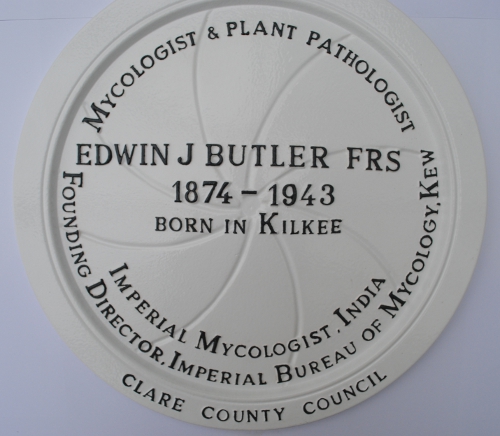|
Edwin John Butler
Sir Edwin John Butler (13 August 1874 – 4 April 1943) was an Irish mycologist and plant pathologist. He became the Imperial Mycologist in India and later the first director of the Imperial Bureau of Mycology in England. He was knighted in 1939.''Oxford Dictionary of National Biography'' http://www.oxforddnb.com/ During his twenty years in India, he began large scale surveys on fungi and plant pathology and published the landmark book ''Fungi and Disease in Plants: An Introduction to the Diseases of Field and Plantation Crops, especially those of India and the East'' (1918) and has been called the Father of Mycology and Plant Pathology in India. Background and education E.J. Butler was born in Kilkee, County Clare, Ireland the son of Thomas Butler, a resident magistrate. He initially went to school in Gainsborough, Lincolnshire but returned to Ireland in 1887 due to illness and studied under a tutor. A library in Cahersiveen where his father was transferred helped him d ... [...More Info...] [...Related Items...] OR: [Wikipedia] [Google] [Baidu] |
Kilkee
Kilkee () is a coastal town in County Clare, Ireland. It is located in the parish of Kilkee ''(formerly Kilfearagh)''. Kilkee is midway between Kilrush and Doonbeg on the N67 road and is a popular seaside resort. The horseshoe bay is protected from the Atlantic Ocean by the Duggerna Reef. History In the early 19th century, Kilkee was a small fishing village. Around the 1820s, a paddle steamer service from Limerick to Kilrush made Kilkee more accessible as a tourist destination, particularly for the Anglo-Irish aristocracy. Catty Fitzgerald opened the first hotel, which operated for 40 years. By the 1830s, two more hotels opened in Kilkee. Along with these, three churches were built, a Roman Catholic church in 1831, a Protestant church in 1843, and a Methodist church in 1900. Descriptions of Kilkee during the Irish Famine can be found in John Manners’s travel narrative ''Notes of an Irish Tour, in 1846'' and Sydney Godolphin Osborne's ''Gleanings in the West of Irelan ... [...More Info...] [...Related Items...] OR: [Wikipedia] [Google] [Baidu] |
Pythium
''Pythium'' is a genus of parasitic oomycetes. They were formerly classified as fungi. Most species are plant parasites, but '' Pythium insidiosum'' is an important pathogen of animals, causing pythiosis. The feet of the fungus gnat are frequently a vector for their transmission. Morphology ;Hyphae: ''Pythium'' species, like others in the family Pythiaceae, are usually characterized by their production of coenocytic hyphae without septations. ;Oogonia: Generally contain a single oospore. ;Antheridia: Contain an elongated and club-shaped antheridium. Ecological importance ''Pythium''-induced root rot is a common crop disease. When the organism kills newly emerged or emerging seedlings, it is known as damping off, and is a very common problem in fields and greenhouses. Thus there is tremendous interest in genetic host resistance, but no crop has ever developed adequate resistance to ''Pythium''. This disease complex usually involves other pathogens such as '' Phytopht ... [...More Info...] [...Related Items...] OR: [Wikipedia] [Google] [Baidu] |
Rust (fungus)
Rusts are fungal plant pathogens of the order Pucciniales (previously known as Uredinales) causing plant fungal diseases. An estimated 168 rust genera and approximately 7,000 species, more than half of which belong to the genus ''Puccinia'', are currently accepted. Rust fungi are highly specialized plant pathogens with several unique features. Taken as a group, rust fungi are diverse and affect many kinds of plants. However, each species has a range of hosts and cannot be transmitted to non-host plants. In addition, most rust fungi cannot be microbial culture, grown easily in pure culture. Most species of rust fungi are able to Heteroecious, infect two different plant hosts in different stages of their life cycle, and may produce up to five Morphology (biology), morphologically and cytologically distinct spore-producing structures viz., spermogonia, aecia, uredinium, uredinia, Telium, telia, and basidia in successive stages of reproduction. Each spore type is very host-specific ... [...More Info...] [...Related Items...] OR: [Wikipedia] [Google] [Baidu] |
Samastipur District
Samastipur is one of the thirty-eight districts of Bihar in India. The district headquarters are located at Samastipur. The district occupies an area of 2904km² and has a population of 4,261,566. Samastipur was the largest milk producing district of Bihar in 2022. History Samastipur became a district in 1972 when it was split from Darbhanga district. Samastipur consists of four sub-divisions: # Rosera # Samastipur # Dalsinghsarai # Shahpur Patori Historically, the Samastipur district has been dominated by Koeri, Yadav and Dusadh castes. There is also a sizeable presence of Bhumihars in some of the regions, but they wield less political influence, as they are not united politically. For this reason, most of the total ten assembly constituencies falling in this district has been dominated by Koeris. The two Lok Sabha constituencies, which are part of this district are also dominated by Koeris and Dusadhs. It has been recorded that in this district, the Koeri and Bhumihar ... [...More Info...] [...Related Items...] OR: [Wikipedia] [Google] [Baidu] |
Indian Agricultural Research Institute
The Indian Agricultural Research Institute (IARI), commonly known as the Pusa Institute, is India's national institute for agricultural research, education and extension. The name Pusa Institute is derived from the fact that the institute was originally located in Pusa, Bihar as the Imperial Institute of Agricultural Research in 1911. It was then renamed as the Imperial Agricultural Research Institute in 1919 and following a major earthquake in Pusa in 1934, it was relocated to Delhi in 1936. The current institute in Delhi is financed and administered by the Indian Council of Agricultural Research (ICAR). The IARI was responsible for the research leading to the " Green Revolution in India" of the 1970s. IARI ranked First among Agriculture and Allied Universities in the National Institutional Ranking Framework NIRF (India Rankings 2024). History The institute was established in 1905 at Pusa, Bihar, with financial assistance of Henry Phipps, Jr., an American philanthropi ... [...More Info...] [...Related Items...] OR: [Wikipedia] [Google] [Baidu] |
Leslie Coleman
Leslie Charles Coleman (16 June 1878 – 14 September 1954) was a Canadian entomologist, plant pathologist and virologist who worked as the first director of agriculture in Mysore State in southern India. He conducted pioneering research on the pests and diseases affecting agriculture in the region and was instrumental in establishing several agricultural research and educational institutions including the Hebbal Agricultural School which later became a part of the University of Agricultural Sciences, Bangalore and the Coffee Research Station at Balehonnur which became the Central Coffee Research Institute. He introduced improved tillage implements, sprayers, tractors, and played a key role in the establishment of the Mysore Sugar Company in Mandya. His major contributions to plant protection included measures to control a rot disease of coffee caused by ''Pellicularia koleroga'' (now ''Ceratobasidium noxium'') known in southern India as ''koleroga''. Coleman established measures f ... [...More Info...] [...Related Items...] OR: [Wikipedia] [Google] [Baidu] |
Sandalwood
Sandalwood is a class of woods from trees in the genus ''Santalum''. The woods are heavy, yellow, and fine-grained, and, unlike many other aromatic woods, they retain their fragrance for decades. Sandalwood oil is extracted from the woods. Sandalwood is often cited as one of the most expensive woods in the world. Both the wood and the oil produce a distinctive fragrance that has been highly valued for centuries. Consequently, some species of these slow-growing trees have suffered over-harvesting in the past. Nomenclature The nomenclature and the taxonomy of the genus are derived from this species' historical and widespread use. Etymologically it is ultimately derived from Sanskrit ''Chandana'' (''čandana''), meaning "wood for burning incense" and related to ''candrah'', "shining, glowing" and the Latin , to shine or glow. It arrived in English via Late Greek, Medieval Latin and Old French in the 14th or 15th century. True sandalwoods Sandalwoods are medium-sized Parasitic pl ... [...More Info...] [...Related Items...] OR: [Wikipedia] [Google] [Baidu] |
Sandal Spike Phytoplasma
Sandalwood (''Santalum album''. L), a semi-root parasitic tree is the source of the East Indian sandalwood and oil. Spike disease caused by phytoplasma is the major disease of sandalwood. The disease is noticed in all major sandal-growing states of India. Spike disease is characterized by extreme reduction in leaf size accompanied by stiffening and reduction of internode length. In advanced stage, the entire shoot gives the appearance of a spike inflorescence. Spiked trees die within one–two years after the appearance of visible symptoms. The pathogen, sandal spike phytoplasma, was first detected by electron microscopy in 1969. Phytoplasmas are pleomorphic and fragile organisms occupying relatively small areas within the sieve tubes (phloem) of the host plants. The major obstacle limiting research on phytoplasma disease is that the organism has not so far been isolated and cultivated ''in vitro''. Sandal spike phytoplasma is a pleomorphic microorganism and are the smallest orga ... [...More Info...] [...Related Items...] OR: [Wikipedia] [Google] [Baidu] |
Kodagu
Kodagu district () (also known by its former name Coorg) is an administrative List of districts of Karnataka, district in the Karnataka state of India. Before 1956, it was an administratively separate Coorg State at which point it was merged into an enlarged Mysore State. Geography Kodagu is located on the eastern slopes of the Western Ghats. It has a geographical area of . The district is bordered by Dakshina Kannada district to the northwest, Hassan district to the north, Mysore district to the east, Kasaragod district of Kerala in west and Kannur district of Kerala to the southwest, and Wayanad district of Kerala to the south. It is a hilly district, the lowest elevation being above sea-level near makutta. The highest peak, Tadiandamol, rises to , with Pushpagiri, Karnataka, Pushpagiri, the second highest, at . The main river in Kodagu is the Kaveri (Cauvery), which originates at Talakaveri, located on the eastern side of the Western Ghats, and with its tributaries, dr ... [...More Info...] [...Related Items...] OR: [Wikipedia] [Google] [Baidu] |
Dehradun
Dehradun (), also known as Dehra Doon, is the winter capital and the List of cities in Uttarakhand by population, most populous city of the Indian state of Uttarakhand. It is the administrative headquarters of the eponymous Dehradun district, district and is governed by the Dehradun Municipal Corporation, with the Uttarakhand Legislative Assembly holding its winter sessions in the city as its winter capital. Part of the Garhwal division, Garhwal region, and housing the headquarters of its Divisional Commissioner, Dehradun is one of the "National Capital Region (India)#Counter magnets, Counter Magnets" of the National Capital Region (India), National Capital Region (NCR) being developed as an alternative centre of growth to help ease the migration and population explosion in the Delhi metropolitan area and to establish a smart city in the Himalayas. Dehradun is located in the Doon Valley on the foothills of the Himalayas nestled between Song River (India), Song River, a tributary ... [...More Info...] [...Related Items...] OR: [Wikipedia] [Google] [Baidu] |
Kolkata
Kolkata, also known as Calcutta ( its official name until 2001), is the capital and largest city of the Indian state of West Bengal. It lies on the eastern bank of the Hooghly River, west of the border with Bangladesh. It is the primary financial and commercial centre of eastern and northeastern India. Kolkata is the seventh most populous city in India with an estimated city proper population of 4.5 million (0.45 crore) while its metropolitan region Kolkata Metropolitan Area is the third most populous metropolitan region of India with a metro population of over 15 million (1.5 crore). Kolkata is regarded by many sources as the cultural capital of India and a historically and culturally significant city in the historic region of Bengal.————— The three villages that predated Calcutta were ruled by the Nawab of Bengal under Mughal suzerainty. After the Nawab granted the East India Company a trading license in 1690, the area was developed by ... [...More Info...] [...Related Items...] OR: [Wikipedia] [Google] [Baidu] |






